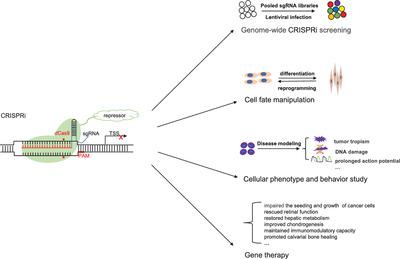Our official English website, www.x-mol.net, welcomes your
feedback! (Note: you will need to create a separate account there.)
dCas9 techniques for transcriptional repression in mammalian cells: Progress, applications and challenges
BioEssays ( IF 3.2 ) Pub Date : 2021-07-29 , DOI: 10.1002/bies.202100086 Yuanyuan Li 1 , Li-Quan Zhou 1
BioEssays ( IF 3.2 ) Pub Date : 2021-07-29 , DOI: 10.1002/bies.202100086 Yuanyuan Li 1 , Li-Quan Zhou 1
Affiliation

|
Innovative loss-of-function techniques developed in recent years have made it much easier to target specific genomic loci at transcriptional levels. CRISPR interference (CRISPRi) has been proven to be the most effective and specific tool to knock down any gene of interest in mammalian cells. The catalytically deactivated Cas9 (dCas9) can be fused with transcription repressors to downregulate gene expression specified by sgRNA complementary to target genomic sequence. Although CRISPRi has huge potential for gene knockdown, there is still a lack of systematic guidelines for efficient and widespread use. Here we describe the working mechanism and development of CRISPRi, designing principles of sgRNA, delivery methods and applications in mammalian cells in detail. Finally, we propose possible solutions and future directions with regard to current challenges.
中文翻译:

用于哺乳动物细胞转录抑制的 dCas9 技术:进展、应用和挑战
近年来开发的创新功能丧失技术使得在转录水平上靶向特定基因组位点变得更加容易。CRISPR 干扰 (CRISPRi) 已被证明是敲除哺乳动物细胞中任何感兴趣的基因的最有效和特异的工具。催化失活的 Cas9 (dCas9) 可以与转录抑制因子融合,以下调与目标基因组序列互补的 sgRNA 指定的基因表达。尽管 CRISPRi 具有巨大的基因敲除潜力,但仍然缺乏有效和广泛使用的系统指南。在这里,我们详细描述了CRISPRi的工作机制和发展,sgRNA的设计原理,传递方法和在哺乳动物细胞中的应用。最后,
更新日期:2021-08-27
中文翻译:

用于哺乳动物细胞转录抑制的 dCas9 技术:进展、应用和挑战
近年来开发的创新功能丧失技术使得在转录水平上靶向特定基因组位点变得更加容易。CRISPR 干扰 (CRISPRi) 已被证明是敲除哺乳动物细胞中任何感兴趣的基因的最有效和特异的工具。催化失活的 Cas9 (dCas9) 可以与转录抑制因子融合,以下调与目标基因组序列互补的 sgRNA 指定的基因表达。尽管 CRISPRi 具有巨大的基因敲除潜力,但仍然缺乏有效和广泛使用的系统指南。在这里,我们详细描述了CRISPRi的工作机制和发展,sgRNA的设计原理,传递方法和在哺乳动物细胞中的应用。最后,











































 京公网安备 11010802027423号
京公网安备 11010802027423号